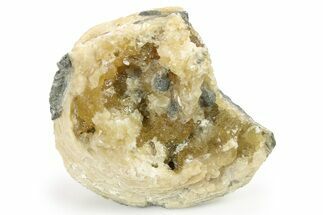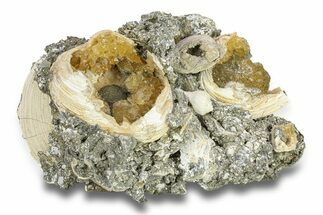This Specimen has been sold.
Pyritized (Pleuroceras) Ammonite & Bivalve Fossil - Germany
This is a beautifully pyritized Pleuroceras ammonite and bivalve fossil collected near Forcheim, Germany. It's Jurassic, Pliensbachian stage or approximately 185 million years old. You can feel the heft of the iron pyrite in the specimen when you hold it in your hand.
Please note that the ammonite and bivalve have been brushed with a wire brush to give them a more brilliant golden shine. Despite being pyritized their natural color when found is much duller.
Please note that the ammonite and bivalve have been brushed with a wire brush to give them a more brilliant golden shine. Despite being pyritized their natural color when found is much duller.
About Ammonites
Ammonites were ancient marine cephalopods, similar to today's squids and octopuses, but with a defining feature: their distinctive, tightly coiled spiral shells. These shells, resembling those of modern nautiluses, served as both a protective home and a buoyancy aid, allowing ammonites to navigate the prehistoric seas with ease. First emerging around 240 million years ago in the Triassic Period, ammonites thrived for over 175 million years, adapting through numerous forms and sizes. As predatory creatures, they likely fed on smaller marine organisms, using their tentacles to capture prey. However, their long reign came to an end 65 million years ago at the close of the Cretaceous, coinciding with the mass extinction event that also eliminated the dinosaurs.
Ammonites were ancient marine cephalopods, similar to today's squids and octopuses, but with a defining feature: their distinctive, tightly coiled spiral shells. These shells, resembling those of modern nautiluses, served as both a protective home and a buoyancy aid, allowing ammonites to navigate the prehistoric seas with ease. First emerging around 240 million years ago in the Triassic Period, ammonites thrived for over 175 million years, adapting through numerous forms and sizes. As predatory creatures, they likely fed on smaller marine organisms, using their tentacles to capture prey. However, their long reign came to an end 65 million years ago at the close of the Cretaceous, coinciding with the mass extinction event that also eliminated the dinosaurs.
SPECIES
Pleuroceras sp. (ammonite)
LOCATION
Forcheim, Germany
SIZE
1.5" wide specimen
CATEGORY
SUB CATEGORY
ITEM
#131117
We guarantee the authenticity of all of our specimens.
 Reviews
Reviews













